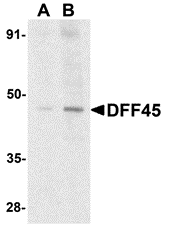Anti-DFF (NT) Antibody (2410)
$445.00
SKU: 2410
Categories: Antibody Products, Apoptosis Antibodies, Products
Overview
Product Name Anti-DFF (NT) Antibody (2410)
Description Anti-DFF (NT) Rabbit Polyclonal Antibody
Target DFF (NT)
Species Reactivity Human
Applications ELISA,WB
Host Rabbit
Clonality Polyclonal
Isotype IgG
Immunogen Peptide corresponding to aa 2-21 at the N-terminus of human DFF45 (accession no. NP_004392).
Properties
Form Liquid
Concentration Lot Specific
Formulation PBS, pH 7.4.
Buffer Formulation Phosphate Buffered Saline
Buffer pH pH 7.4
Format Purified
Purification Purified by peptide immuno-affinity chromatography
Specificity Information
Specificity This antibody recognizes non-cleaved (45kDa) and cleaved DFF.
Target Name DNA fragmentation factor subunitα
Target ID DFF (NT)
Uniprot ID O00273
Alternative Names DNA fragmentation factor 45 kDa subunit, DFF-45, Inhibitor of CAD, ICAD
Gene Name DFFA
Gene ID 1676
Accession Number NP_004392
Sequence Location Cytoplasm.
Biological Function Inhibitor of the caspase-activated DNase (DFF40).
Research Areas Apoptosis
Background A human DNA fragmentation factor (DFF) which is cleaved by caspase-3 during apoptosis was identified recently. The mouse homologue of human DFF was identified as a DNase inhibitor and was designated ICAD. Upon cleavage of DFF/ICAD, a caspase activated deoxyribonuclease (CAD) is released and activated and eventually causes the degradation of DNA in nuclei. Cleavage of CAD inhibitor molecule DFF/ICAD, which causes DNase activation and DNA degradation, is a hallmark of apoptotic cell death.
Application Images


Description Western blot analysis of DFF45 in HeLa cell lysate with DFF45 antibody at (A) 1 and (B) 2 ug/mL.
Handling
Storage This antibody is stable for at least one (1) year at -20°C. Avoid multiple freeze-thaw cycles.
Dilution Instructions Dilute in PBS or medium which is identical to that used in the assay system.
Application Instructions Immunoblotting: use at 2ug/mL.
These are recommended concentrations.
Enduser should determine optimal concentrations for their applications.
Positive control: Whole cell lysate from HeLa cells.
These are recommended concentrations.
Enduser should determine optimal concentrations for their applications.
Positive control: Whole cell lysate from HeLa cells.
References & Data Sheet
Data Sheet  Download PDF Data Sheet
Download PDF Data Sheet
 Download PDF Data Sheet
Download PDF Data Sheet


